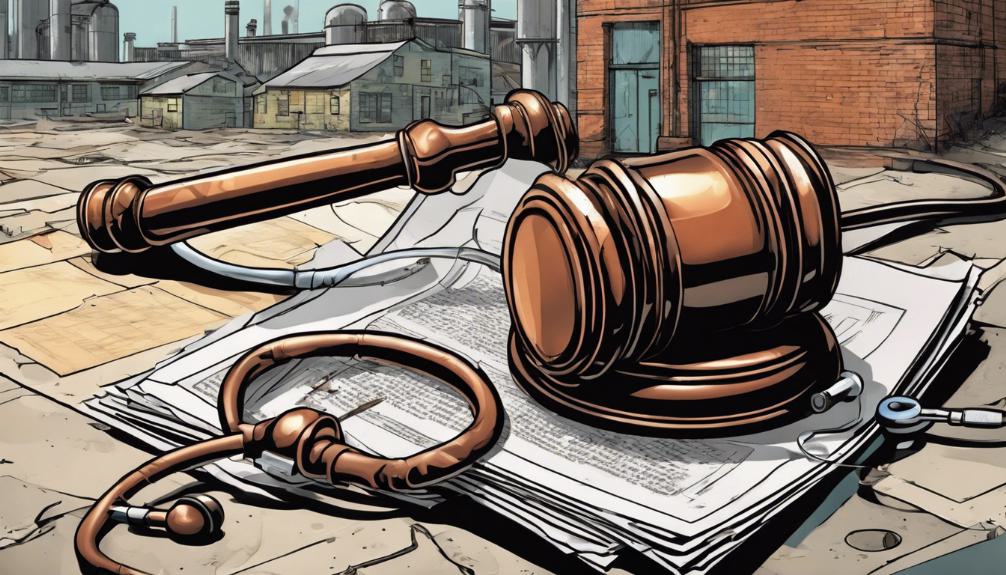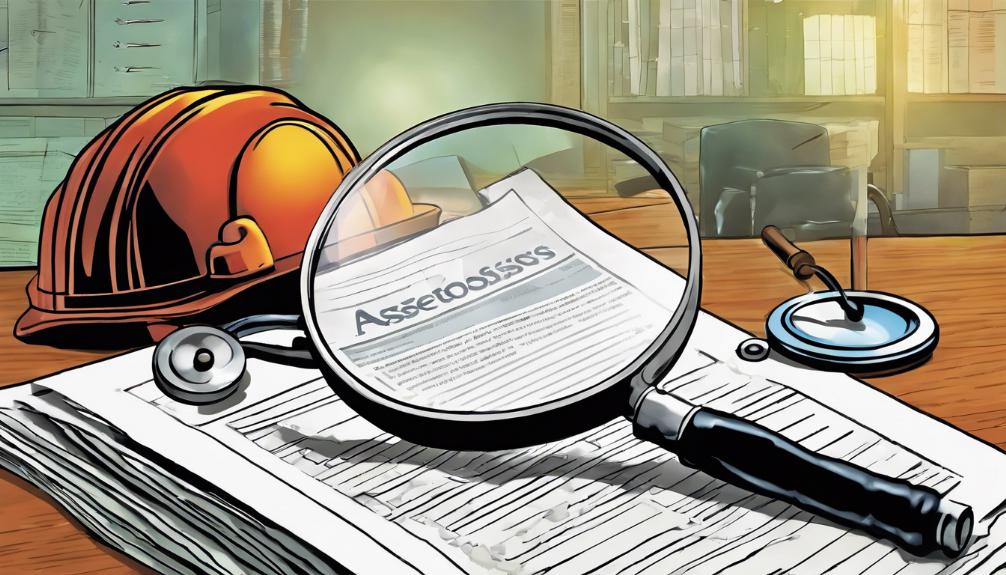Asbestosis Lawsuit Claim: Were You or A Loved One Diagnosed With Asbestosis?
The diagnosis of asbestosis marks a pivotal moment in an individual's life, heralding a journey fraught with medical challenges and potential legal battles. This chronic lung condition, resulting from exposure to asbestos fibers, not only deteriorates health but also raises critical questions about workplace safety and accountability. For those affected, or their loved ones, understanding the intricacies of asbestosis lawsuit claims becomes paramount. Navigating this complex legal landscape requires a nuanced comprehension of the link between exposure and illness, alongside an awareness of the rights and compensations potentially available. Embarking on this path opens the door to seeking justice and financial relief, but what does this journey entail, and how does one prepare for the steps ahead?

Understanding Asbestosis
Asbestosis, a chronic lung condition caused by prolonged exposure to asbestos fibers, leads to the development of scar tissue in the lungs, manifesting through severe respiratory symptoms. This progressive disease significantly impairs lung function, resulting in symptoms such as shortness of breath, persistent cough, and wheezing. Over time, asbestosis can lead to more serious complications, including reduced lung volume, decreased lung compliance, and impaired gas exchange. This can escalate to lung failure and heart failure due to the increased strain on the heart. Diagnosis typically involves imaging tests, lung function tests, and a detailed medical history. As there is no cure for asbestosis, treatment focuses on managing symptoms and may include oxygen therapy and respiratory physiotherapy to improve the quality of life for affected individuals.
Causes of Asbestosis

Prolonged inhalation of asbestos fibers is the primary cause of asbestosis, a serious lung condition characterized by the development of scar tissue. These fibers, once inhaled, can lodge in the lung tissues, leading to irritation and eventual scarring (fibrosis). This process can significantly impair lung function. Asbestos, a group of naturally occurring mineral fibers found in many industrial, construction, and building materials, was widely used for its durability and resistance to heat, fire, and chemicals. Despite its useful properties, asbestos's potential health risks were not fully acknowledged until the latter part of the 20th century. Workers in industries such as construction, shipbuilding, and manufacturing, among others, are at a heightened risk of exposure to asbestos and, consequently, developing asbestosis.
Symptoms and Detection

Identifying the symptoms of asbestosis early can be crucial for managing the disease effectively. Asbestosis, a chronic lung disease caused by asbestos exposure, leads to the formation of scar tissue in the lungs. This scarring manifests through various symptoms, including shortness of breath, persistent cough, wheezing, and dyspnea. These symptoms often worsen over time as the disease progresses. Early detection is key to slowing down the disease's progression and improving the quality of life for the affected individual. Physicians use a combination of patient history, physical examinations, and diagnostic tests, such as chest X-rays and lung function tests, to diagnose asbestosis. Recognizing these symptoms promptly allows for timely medical intervention and management of the condition.
Complications From Asbestosis

Understanding the symptoms of asbestosis is crucial, but it is equally important to recognize the potential complications that can arise from this condition. Asbestosis, a fibrotic lung disease caused by asbestos exposure, can lead to severe health issues beyond the initial symptoms. One of the primary complications is reduced lung volume and decreased lung compliance, making breathing increasingly difficult. This reduction in lung function can severely impair gas exchange, leading to hypoxemia and, in severe cases, respiratory failure. Additionally, the strain on the lungs can affect the heart, potentially resulting in heart failure. These complications highlight the critical nature of monitoring and managing asbestosis to prevent its progression to life-threatening conditions.
Treatment Options

Treatment options for asbestosis focus primarily on alleviating symptoms, as the disease is irreversible and lacks a definitive cure. Management strategies are tailored to individual needs and may include oxygen therapy to ease breathing difficulties and respiratory physiotherapy to enhance lung function. Pulmonary rehabilitation programs can improve overall physical endurance and well-being. In severe cases, a lung transplant may be considered, although it is reserved for those who meet specific criteria due to the procedure's complexity and risks. Medications to manage coughing and chest discomfort might also be prescribed. Importantly, patients are advised to avoid further exposure to asbestos and to quit smoking to prevent exacerbation of the condition. Continuous monitoring by healthcare professionals is crucial for adapting treatment plans as the disease progresses.
Legal Rights and Claims

While managing asbestosis through medical interventions is critical, exploring legal avenues for compensation can also provide significant support to those affected by asbestos exposure. Individuals diagnosed with asbestosis may have the right to seek compensation from employers, manufacturers, or other parties responsible for their exposure. This compensation can cover medical expenses, lost wages, and pain and suffering. It's essential to understand that legal rights vary by jurisdiction and depend on specific circumstances surrounding the exposure. Consulting with an experienced asbestos litigation attorney can help clarify these rights and the potential for a successful claim. Legal professionals in this field are equipped to navigate the complexities of asbestos litigation, providing invaluable guidance through the process of seeking justice and financial relief for victims and their families.
Filing an Asbestosis Lawsuit

Filing an asbestosis lawsuit begins with the crucial step of identifying all parties potentially responsible for the asbestos exposure that led to the diagnosis. This process involves comprehensive research into the victim's work history, living conditions, and any products they may have been exposed to containing asbestos. Legal professionals specializing in asbestosis cases possess the expertise to sift through employment records, product catalogs, and company histories to pinpoint liable entities. Once identified, the next phase involves collecting medical evidence to establish a direct link between the exposure and the asbestosis diagnosis. This includes obtaining detailed medical records, expert opinions, and conducting tests that corroborate the presence of asbestosis. The meticulous preparation of this foundational evidence is critical for advancing the lawsuit toward a successful legal resolution.
Settlements and Compensation

Navigating through the complexities of asbestosis lawsuit settlements, victims seek fair compensation for their suffering and medical expenses. Settlements in these cases often reflect the severity of the disease, including the cost of medical treatments, lost wages, and pain and suffering. Since asbestosis is a progressive disease that can lead to severe health complications, including lung and heart failure, compensation also considers future medical needs and life care expenses. Victims may receive compensation through individual lawsuits against manufacturers or employers, or through asbestos trust funds established by bankrupt entities. The amount of compensation varies, with factors such as the victim's age, medical history, and the extent of asbestos exposure influencing the settlement. Successfully navigating these settlements requires a thorough understanding of asbestosis and its impact on an individual's health and livelihood.
Choosing the Right Lawyer

Selecting an experienced attorney is crucial for individuals diagnosed with asbestosis seeking legal recourse for their condition. The complexity of asbestosis cases demands a lawyer with a deep understanding of both the legal and medical aspects of the disease. Ideally, this means choosing someone who has a proven track record of handling asbestosis or other asbestos-related disease cases. Look for a lawyer who demonstrates comprehensive knowledge about the history of asbestos use, its health impacts, and precedent settlements or verdicts in similar cases.
Additionally, consider the level of personal attention and resources the lawyer is willing to commit to your case. A dedicated attorney should not only be adept at navigating the legal system but also compassionate towards your situation, ensuring your rights are fully represented and your case is given the attention it deserves.
Preparing Your Case

After choosing an experienced attorney well-versed in asbestosis cases, the next critical step involves meticulously preparing your case to ensure all relevant medical and exposure history is accurately represented. This preparation includes gathering comprehensive medical records that document your asbestosis diagnosis, symptoms, and any treatments undergone. It's essential to compile a detailed work history, pinpointing periods and environments where asbestos exposure occurred. Affidavits from coworkers or industry experts can bolster claims about the exposure's extent and its link to your condition. Additionally, documenting the impact of asbestosis on your daily life, including limitations on activities and any financial losses due to medical expenses or lost wages, is crucial. This thorough preparation forms the foundation of a compelling case, highlighting the direct consequences of asbestos exposure on your health.
What to Expect in Court

When pursuing an asbestosis lawsuit, understanding the procedural dynamics and expectations of court proceedings is crucial for plaintiffs. The process begins with the pre-trial phase, where both parties exchange evidence and testimonies during discovery. This stage is foundational, allowing each side to build their case by gathering medical records, expert analyses, and witness accounts. Following discovery, pre-trial motions may be filed to address legal questions affecting the trial's scope or direction.
In court, plaintiffs should anticipate a detailed presentation of their medical history and exposure to asbestos, supported by expert testimony. The defense may challenge the causation link between asbestos exposure and the plaintiff's condition, necessitating robust evidence and persuasive argumentation from the plaintiff's legal team. Understanding these steps helps prepare plaintiffs for the complexities of legal proceedings in asbestosis cases.
After the Verdict

Securing a verdict in an asbestosis lawsuit marks the beginning of a new phase for plaintiffs, focusing on the implementation of the court's decision. After the verdict, the winning party must navigate the process of collecting the awarded compensation. This often involves further legal maneuvers, especially if the losing party decides to appeal the decision. In such cases, the judgment may be delayed, requiring additional patience and legal guidance from the plaintiff's side. It's crucial for plaintiffs to stay in close contact with their attorneys to understand the steps involved in enforcing the verdict. Additionally, financial planning becomes essential as compensation may be structured over time or require adjustments based on appeal outcomes. This phase demands diligent follow-up and a clear understanding of legal rights to ensure the full benefit of the verdict is realized.
Frequently Asked Questions
How Does Living With Asbestosis Impact Daily Life and Mental Health?
Living with asbestosis significantly impacts daily life and mental health due to its progressive nature and lack of a definitive cure. Individuals may experience a reduction in physical capabilities, including difficulty in breathing and engaging in routine activities, leading to emotional distress and anxiety. The irreversible damage to lung function necessitates ongoing management, including oxygen therapy and respiratory physiotherapy, which can further affect one's lifestyle and psychological well-being.
Can Lifestyle Changes or Alternative Therapies Complement Traditional Asbestosis Treatment?
In managing asbestosis, lifestyle changes and alternative therapies can complement traditional treatments, though they cannot reverse the condition. Practices such as quitting smoking, maintaining a balanced diet, and engaging in gentle exercise may improve overall lung health and quality of life. Additionally, psychological support and alternative therapies like acupuncture or massage may help manage symptoms. However, it's essential to consult healthcare professionals before incorporating new practices into a treatment plan.
What Are the Long-Term Financial Implications for Families Dealing With an Asbestosis Diagnosis?
The long-term financial implications for families facing an asbestosis diagnosis can be substantial. The cost of ongoing medical care, including treatments like oxygen therapy and respiratory physiotherapy, can accumulate, placing a significant burden on family finances. Additionally, the potential loss of income due to the affected individual's inability to work exacerbates financial strain. It's crucial for families to explore all available resources and support systems to manage these challenges effectively.
How Does Asbestosis Affect Life Expectancy and What Are the Palliative Care Options Available?
Asbestosis significantly impacts life expectancy, often leading to a progressive decline in lung function. This disease, caused by asbestos exposure, can shorten lifespan due to complications such as respiratory failure and heart issues. Palliative care options focus on symptom management, including oxygen therapy, respiratory physiotherapy, and medication to alleviate discomfort. These measures aim to improve quality of life, as there is currently no cure for asbestosis.
Are There Any Support Groups or Community Resources Specifically for Individuals and Families Affected by Asbestosis?
For individuals and families grappling with asbestosis, various support groups and community resources are available to provide emotional, educational, and practical support. These resources aim to help those affected navigate the complexities of living with asbestosis, offering a platform for sharing experiences, coping strategies, and information on managing symptoms and treatment options. Engaging with these support networks can significantly alleviate the emotional burden and improve the quality of life for sufferers and their families.

This post has been generated by AI and was not reviewed by editors. This is Not legal advice. Please consult with an attorney.




